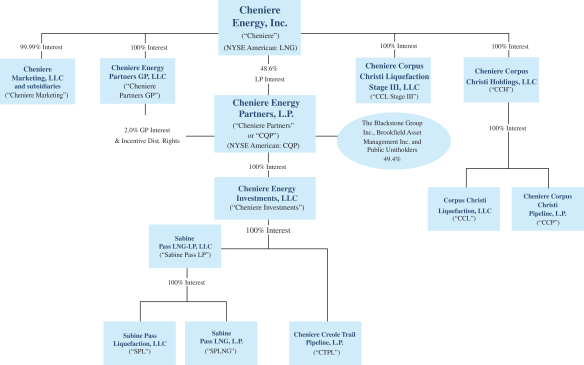(3) the Intercreditor Agreement; and
(4) each of the security agreements, uncertificated security control agreements, financing statements, deposit account control agreements and
other instruments executed and delivered by CEI pursuant to the Credit Facilities, the indenture or any other Additional First Lien Documents for purposes of providing collateral security or credit support for any First Lien Obligation;
as the same may be amended, amended and restated, supplemented or otherwise modified or replaced from time to time.
“Control” means the possession, directly or indirectly, of the power to direct or cause the direction of the management and policies of a
Person, whether through the ownership of voting securities, by contract or otherwise.
“CQH” means Cheniere Energy Partners LP Holdings,
LLC.
“CQP” means Cheniere Energy Partners, L.P.
“Credit Agreement” means, that certain Amended and Restated Revolving Credit Agreement, dated as of December 13, 2018, by and among CEI,
the lenders party thereto from time to time and Société Générale, as administrative agent, as it may be further amended, amended and restated, supplemented or otherwise modified from time to time.
“Credit Facilities” means the Credit Agreement and the Term Loan Credit Agreement.
“Credit Facilities Obligations” means, as applicable the “Obligations” as defined in the Credit Agreement and the Term Loan Credit
Agreement.
“Credit Facilities Secured Parties” means with respect to the Credit Agreement, the holders of the “Obligations” as
defined in the Credit Agreement, the administrative agent under the Credit Agreement, any other agent or similar Person therefor under the Credit Agreement and the beneficiaries of each indemnification obligation undertaken by CEI under the Credit
Agreement, and, with respect to the Term Loan Credit Agreement, the holders of the “Obligations” as defined in the Term Loan Credit Agreement, the administrative agent under the Term Loan Credit Agreement, any other agent or similar Person
therefor under the Term Loan Credit Agreement and the beneficiaries of each indemnification obligation undertaken by CEI under the Term Loan Credit Agreement.
“Credit Facility Administrative Agent” means, as applicable, Société Générale, as administrative agent under the
Credit Agreement, or Société Générale, as administrative agent under the Term Loan Credit Agreement.
“Default” means any event, act or condition that is, or after notice or passage of time or both would be, an Event of Default.
“Disqualified Equity” means any Equity Interest that, by its terms (or by the terms of any security into which it is convertible, or for
which it is exchangeable, in each case, at the option of the holder of the Equity Interest), or upon the happening of any event, matures or is mandatorily redeemable, pursuant to a sinking fund obligation or otherwise, or redeemable at the option of
the holder of the Equity Interest, in whole or in part, on or prior to the date that is 91 days after the date on which the notes mature (other than pursuant to a change of control or asset sale prepayment offer provision).
“Dollars” and “$” means lawful money of the United States.
“Equity Interests” means Capital Stock and all warrants, options or other rights to acquire Capital Stock (but excluding any debt security
that is convertible into, or exchangeable for, Capital Stock).
63
